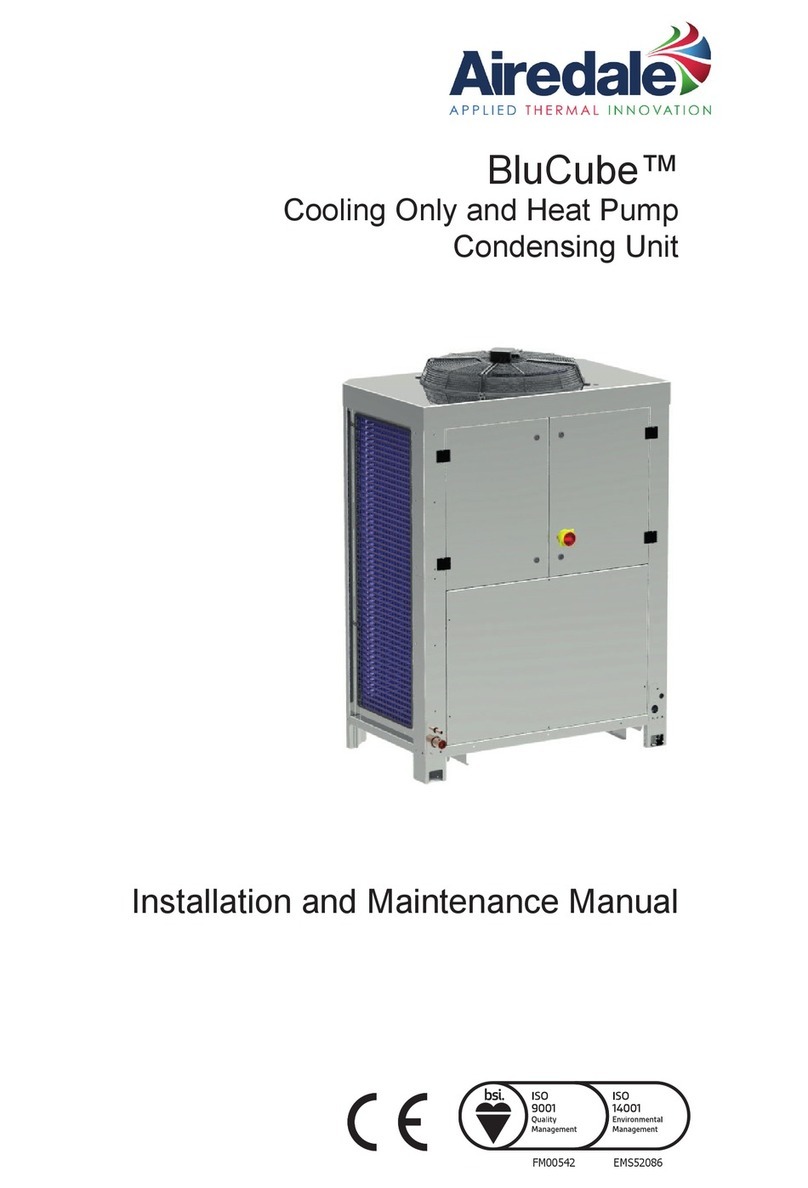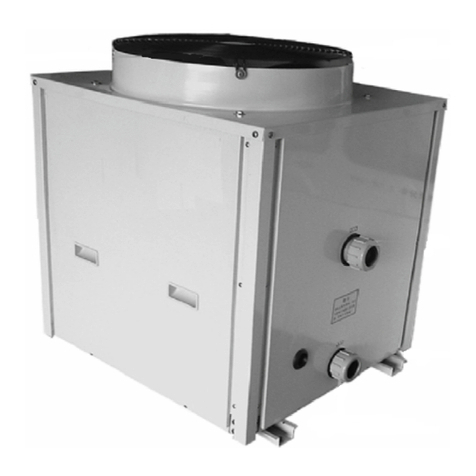
7
3.2 SAFETY SYSTEMS
Below are a number of recommendations that
must be observed durin the installation, start-up
and maintenance of the system.
The safety accessories required in point 2.5 of
this manual must be installed, in particular the
water inlet filter and the water flow control valve.
3.2.1 Freezing
The freezin of water inside the tubes is not a
common phenomenon in condensers. Freezin
may occur when a hi h char e of refri erant is
rapidly dispersed outside of the refri erant circuit
from the condenser or nearby. One of the most
frequent cases involves the openin of the valve
due to excessive pressure head. This occurs
when the water temperature is hi h or the flow of
water is closed. Another cause may be the acci-
dental breaka e of a refri erant line or the
removal of the refri erant from an inactive unit.
Freezin may also be caused by the incomplete
drainin of the exchan er, which is exposed to
low temperatures durin the periods of system
inactivity. In this re ard, the procedure indicated
in the chapter on Inspection and Maintenance
should be carefully followed.
3.2.2 Vibrations
Excessive vibrations on both the water side and
the refri erant side may cause si nificant dam-
a e to the condenser over time. To reduce the
transmission of vibrations on the water side,
install vibration dampers near the water connec-
tions, on the supports and on the structure. For
the refri erant side, on the other hand, use the
vibration-dampin devices described in point 2.5
of this manual. In the case where the condenser
is installed as a support element for the compres-
sor, measures must be taken to avoid the trans-
mission of vibrations to the condenser.
3.2.3 Water pump shut-down
When stoppin the system, a delay should be set
for shuttin down and startin the pumps, so as
to avoid an increase in the water temperature
inside the tubes, with the risk of deposit forma-
tion.
3.3 WATER QUALITY AND TREATMENT
It is the user’s responsibility to establish the qual-
ity of the water and make sure that this is compat-
ible with the materials used in the condenser, see
Table 9. The quality of the water, for the reasons
described above, may si nificantly affect the
operation and the life of the exchan er. The first
step in plannin the treatment of the water is
chemical analysis, which must be performed by
qualified personnel from specialist or anisations.
For information and su estions on this subject,
refer to chapter 6 of the "Plate heat exchan ers
for refri eration applications - Technical refer-
ence manual" published by Alfa Laval.
The followin methods can be used to clean the
inside of the tubes:
• mechanical, by swabbin inside the tubes: this
procedure can be applied only to units with tra-
ditional smooth tubes;
• chemical, performed by runnin commercially-
available solutions throu h the tubes, accord-
in to the type of foulin , or anic or inor anic.
This method can be used with all types of tube,
both smooth and fluted on the inside, and must
be performed by qualified personnel only.
Cleanin may be performed with mechanical
methods, or chemical methods usin commer-
cially-available products with a dual action, that
is, the removal of the scale and the prevention of
corrosion. One recommended product is P3 T288
by Henkel.
In tower water, as shown above, the tendency to
form deposits may be hi h: to reduce this phe-
nomenon, there are various types of water sof-
tenin treatments available, includin the use of
ion exchan e resins.
3.4 WATER SPEED INSIDE THE TUBE
Erosion and impin ement may occur if the speed
exceeds the required limits, as the solid particles,
such as sand and dust, suspended in the mass of
water combine to erode the surface of the metal.
The use of filters and the observance of the set
water speed limits in the hydraulic system
reduces the risk of corrosion to an acceptable
limit.
Never exceed the maximum water flow rate lim-
its. The values can be checked usin the data in
the "Alfa Laval Condensers Catalo ue".
3.5 CORROSION
The oxy en dissolved in water increases the rate
of corrosion. The main factors causin corrosion
are sulphur and carbon dioxide acids, see the
Lan elier and Ryznar indices. A combined effect
of foulin due to dust and or anic material pro-
vides a support for bacteria, fun i and al ae; the
rowth of or anisms may produce an oxy en
radient and this results in rather severe pittin of
the surface of the metal.
The phenomenon of corrosion is obviously
related to the materials used on the liquid side of
the heat exchan er, see Table 9.
Table 10 shows the reference values for corro-
sion on copper; these values must be considered
as uidelines to avoid corrosion.
3.6 USE OF BRINE
Secondary fluids consistin of water and ethylene
or propylene lycol solutions are enerally not
corrosive, unless contaminated by other sub-
stances. If usin calcium chloride, refer to the
warnin s in para raph 5.3.2, chapter 6, of the
"Plate heat exchan ers for refri eration applica-
tions - Technical reference manual" published by
Alfa Laval.
Before usin any other secondary fluid, check
with Alfa Laval that it is compatible with the
exchan er.



























